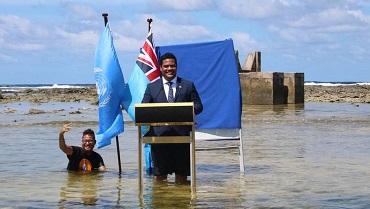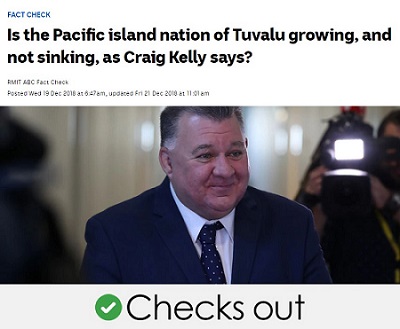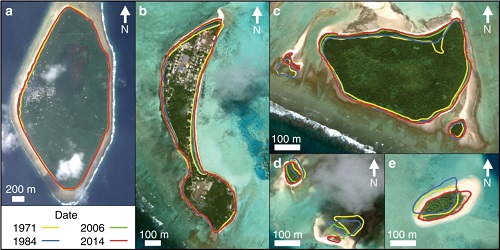Perhaps the most dramatic scene at the COP26 Summit in Glasgow was the speech by the Foreign Minister of the Pacific island nation of Tuvalu. Simon Kofe filmed his 9 November speech, beamed into Glasgow, standing knee-deep in the ocean at Tuvalu, to highlight the threat of rising sea levels. There’s only one problem—Tuvalu is growing, not sinking.
On 19 December 2018, ABC reported on its RMIT-ABC Fact Check of then-Liberal Party MP Craig Kelly’s claim that the science shows “Tuvalu is actually growing not sinking”. The RMIT-ABC Fact Check reported its verdict: “Mr Kelly’s claim checks out.”
ABC reported the claim is confirmed in a peer-reviewed study by the University of Auckland published in Nature Communications in 2018, “Patterns of island change and persistence offer alternate adaptation pathways for atoll nations”. An analysis of shoreline change in all 101 islands in the Pacific atoll nation using four decades of remotely sensed data, the abstract of the paper states:
“Results highlight a net increase in land area in Tuvalu of 73.5ha (2.9 per cent), despite sea-level rise, and land area increase in eight of nine atolls. Island change has lacked uniformity with 74 per cent increasing and 27 per cent decreasing in size. Results challenge perceptions of island loss, showing islands are dynamic features that will persist as sites for habitation over the next century, presenting alternate opportunities for adaptation that embrace the heterogeneity of island types and their dynamics.”
ABC reported: “Notably, Tuvalu Prime Minister Enele Sopoaga criticised the research, claiming it had not considered the habitability of the new land area. But [study co-author] Professor Kench told Fact Check this was not the case: ‘These islands are essentially deposits of gravel and sand’, he said. ‘The accreted material is no different to the older material.’ His previous research demonstrated similar growth in the atoll islands of Kiribati.”
ABC added this interesting caveat: “However, the United Nations Intergovernmental Panel on Climate Change (IPCC) sets out four scenarios for future rises, three of them more severe than what Tuvalu has so far faced.” This is a reference to a little understood detail of climate change projections, which is that there are four emissions scenarios of increasing severity, called Representative Concentration Pathways (RCP) of which the most severe, RCP8.5, is the least likely, but is the basis for most of the alarmist commentary in the media.
Roger Pielke Jr. is a professor at the Centre for Science and Technology Policy Research at the University of Colorado Boulder, a former staff scientist in the Environmental and Societal Impacts Group of the US National Centre for Atmospheric Research, and the son of renowned atmospheric scientist Roger A. Pielke. In a 2018 article for Issues in Science and Technology, “Opening up the climate policy envelope”, Pielke Jr. explained RCP 8.5: “The RCP 8.5 scenario is based on an assumption of the dramatic expansion of coal energy around the world over the twenty-first century that results in extremely high carbon dioxide emissions, in fact the most emissions of any scenario used by the IPCC in its Fifth Assessment Report. Despite its outlier status, RCP 8.5 is the most commonly used scenario in climate impact studies, appearing in thousands of academic papers. Climate impact studies generally use physical climate models to project how the climate system might change in the future, with particular attention to such phenomena as heat waves, floods, drought, and hurricanes. The use of an extreme emissions scenario yields larger and more significant changes to climate in the future. The characterisation of an extreme scenario as ‘business as usual’ implies that it is a baseline scenario, a vision of what is likely to happen in the absence of climate policies.
“However, RCP 8.5 is not a business-as-usual scenario and has been criticised for its unrealism. Justin Ritchie and Hadi Dowlatabadi concluded in 2017 that ‘evidence indicates that RCP 8.5 does not provide a physically consistent worst case BAU [business-as-usual] trajectory that warrants continued emphasis in scientific research, it does not provide a useful benchmark in policy studies.’ In early 2017 the team of researchers responsible for producing the scenarios that will underpin IPCC’s Sixth Assessment observed that emissions consistent with RCP 8.5 ‘can only emerge under a relatively narrow range of circumstances’.
“Yet RCP 8.5 remains a scenario favoured in most climate impacts studies published in the academic literature. One reason for this is obvious: because the scenario generates very high carbon dioxide emissions, the associated climate impacts projected in climate models can also be very large, and thus lend continued urgency to calls for emissions reductions, and supporting economic models that show very high costs of future climate change impacts.”
The claim of a climate change consensus is a political claim, not a scientific one. Thus far it has served to fuel the demands for “action” that tend to prioritise carbon trading schemes from which global banks are best positioned to profit (p. 8); increasingly, it is becoming another geopolitical cudgel with which to beat countries like Russia and China, which get attacked for addressing climate change in their own way because they don’t share the sense of urgency that dominates the debate in the West.
Political claims of a consensus must not be a pretext to suppress the scientific debate and inconvenient facts. When the narrative of the need for urgency in action on climate change is based on predictions of more floods, more droughts, more bushfires, more storms, the destruction of the Great Barrier Reef, and rising sea levels threatening Pacific islands, those predictions must be measured and verified. There is a fierce debate about all of those predictions, which space doesn’t allow to report here, but according to the ABC and RMIT at least, the political stunt by the Tuvalu foreign minister is not backed up by the facts. Remember that when you hear the coming political attacks on India, China, and Russia for watering down the deal at COP26.
By Robert Barwick, Australian Alert Service, 17 November 2021









